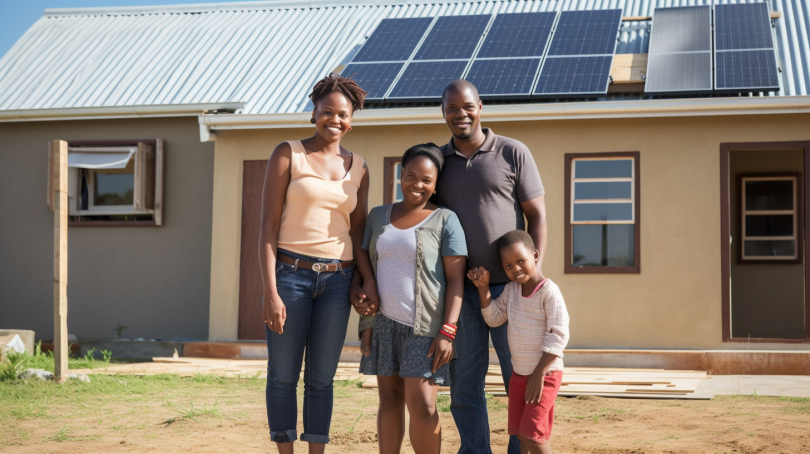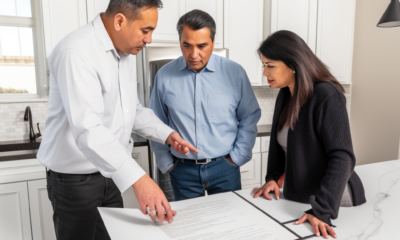Home improvement financing
Understanding Home Equity Lines of Credit (HELOCs)
A home equity line of credit, or HELOC, is a type of loan that allows homeowners to borrow against the equity they have built up in their property. It works like a credit card, with a predetermined credit limit that can be drawn upon as needed. HELOCs offer flexibility and lower interest rates than traditional loans, making them an attractive option for homeowners looking to finance large expenses or consolidate high-interest debt. However, it is important to understand the risks involved with borrowing against your home’s equity and to carefully consider whether a HELOC is the right choice for you.
When it comes to purchasing a home, there are numerous financing options that you may consider, and one of them is a home equity line of credit (HELOC). A home equity line of credit functions like a second mortgage and is ideal for those looking to access the equity in their homes. Unlike other loan types, a HELOC allows you to borrow money against the equity in your home on an as-needed basis, and in some cases, at lower interest rates than other loan types. However, before obtaining a HELOC, it is essential to understand how it works, its benefits and drawbacks, and whether it’s right for your financial needs.
What is a home equity line of credit?
A home equity line of credit, or HELOC, is a type of loan tied to your home’s value. When homeowners build equity in their homes – the difference between the market value of a property and the outstanding balance on any loans associated with it – they can use it to obtain cash through a home equity line of credit. Think of a HELOC as a revolving credit line that works similarly to a credit card.
HELOCs operate similarly to second mortgages but have unique features such as higher interest rates and shorter repayment terms. The funds you borrow are collateralized by your home, meaning that if you are unable to pay off the HELOC, your lender may foreclose on your home.
How does a home equity line of credit work?
A HELOC operates like any other loan in that you receive funds that you must repay with interest over time. In this case, however, your house secures it. A HELOC provides you with funding up to an approved amount (your credit limit), and unlike other loan types where you receive money upfront, you can draw from your pre-approved limit as needed during the draw period.
The “draw period” during which homeowners can borrow against their equity and only pays interest on what they’ve borrowed. The draw period typically lasts anywhere from five to ten years, after which homeowners must begin repaying both principal and interest within a set period known as the repayment period.
Variable vs. fixed-rate home equity lines of credit
Your interest rate can depend entirely on different factors like fluctuations in prime rates or Federal Reserve policy changes. Depending on your preferences and long-term goals, it may be best to choose either a fixed or variable interest rate for your HELOC.
- A variable rate home equity line of credit can fluctuate with prime rates and changes in federal policy over time; some variable rate plans feature an initial fixed rate period, often six months or one year, before switching into variable rates.
- In contrast, those who prefer more predictable payments may be interested in fixed-rate plans instead.
The Benefits and drawbacks of home equity lines of credit
HELOCs are useful financial tools for homeowners who want to access the equity they’ve built up in their homes without selling them. Some benefits include:
- Flexibility: While other loans require borrowers to collect their full funds upfront as soon as they’re approved for financing, homeowners with HELOCs draw money out of their accounts only when needed during the draw period.
- Lower interest rates: Generally speaking, interest rates on HELOCs tend to be lower than unsecured loans because they are backed by the borrower’s property.How does a home equity line of credit work?
A home equity line of credit, or HELOC, can seem like a complicated financial instrument. Essentially, it’s a loan taken out with your house as collateral. This section will cover all you need to know about how this kind of loan works to help you make an informed decision about whether it might be the right financial move for you.
What is a draw period?
The HELOC “draw period” or credit line access period is the period during which funds are available to borrow. It’s the borrowing phase of your home equity line of credit because you can draw on the line when needed, up to the approved limit, and pay interest only on what is borrowed. Typically, draw periods last around 5 years to 10 years during which the borrower is only required to pay interest on the money they’ve used
The repayment term
The repayment term of a HELOC occurs after the draw period expires. At the end of the draw period, homeowners must begin repaying both principal (the amount borrowed) as well as interest within a set period known as repayment term.
The repayment term lasts 10-20 years after which all outstanding balances must be paid off in full. During the repayment term, you’ll stop using your draw period and transition into paying off what was borrowed.
Credit Limit
Your lender will set a maximum credit limit when you apply for a HELOC; it serves as the maximum amount you can borrow against your home equity. As long as there’s adequate equity available in your home and no changes to your financial health, your lender won’t typically reduce your limit after approval.
Interest rates
HELOC’s interest rates are often adjustable –that means they can go up or down based on other factors like Federal Reserve policy changes or shifts in prime rates over time. Some lenders offer promotional one-time fixed rates that last for a short time before changing over into the variable rate.
What happens if You default on HELOC?
If you’re unable to make timely payments toward your HELOC, and if any remaining balance becomes too large or if payments remain unpaid for too long, then the bank can foreclose on your property since it provides collateral for this type of financing.
In conclusion, a Home Equity Line Of Credit works by giving homeowners access to their built-up home equity through flexible borrowing and repayment phases. Your timeline and interest rates can easily fluctuate based on market trends and various other factors such as federal policy changes or shifts in prime rates . Make sure you accurately evaluate your needs and financial status before deciding whether getting a HELOC is suitable for you.
Pros and cons of a home equity line of credit
A Home Equity Line of Credit (HELOC) can be a fantastic way for homeowners to tap into their home’s equity. However, there are pros and cons one must consider before accepting any form of credit that involves risking their home as a guarantee.
Pros
- Lower Interest Rates: HELOCs typically offer lower interest rates than other forms of credit, since they are secured by your home’s equity.
- Flexibility: Unlike traditional loans, you only need to use borrowed money as you need it, paying interest only on the amount used. Also, HELOCs have a flexible payment structure like that similar to a credit card.
- No upfront fees: Most lenders don’t charge fees up front for borrowers to receive access to their HELOC funds.
- Terms: The typical draw period lasts 5-10 years, while repayment usually peaks between 10-20 years allowing the borrower to take time in paying off the amount owed.
Cons
- Risking Your Home:The primary risk is the potential foreclosure on your home if you become unable to pay back your HELOC payments, putting your homeowner status at risk.
- Evolving Interest Rates: The interest rates on a HELOC can increase over time, meaning that if they rise too high, or if you have difficulty keeping up with repayments, then this form of credit can become substantial financial stress.
- Decline in Property Value: If property values decline after taking out a HELOC, you might end up owing more than the value of your house in the event of foreclosure.
- Fees and Charges:Lenders typically require applicants to pay an origination fee as well as annual maintenance fees during the draw period of their home equity line of credit.
Are you Ready For A HELOC?
A HELOC can be an excellent financing tool for homeowners with solid earnings and significant home equity who wish to consolidate debt or pay for renovations or medical bills/treatments. Before selecting any financing option and applying for them; make sure you evaluate all associated risks and fees.
Rather than solely focusing on interest rates and fees associated with the HELOC agreement, ensure that borrowing against your home suits your present and future financial status better than other forms of credit such as personal loans, lines of credit or mortgage refinancing options available to homeowners.
How to apply for a home equity line of credit
If you’ve decided that a Home Equity Line of Credit (HELOC) is the right choice for your borrowing needs, there are steps you should follow to obtain one.
Evaluate Your Financial Health
The first step in applying for a HELOC is determining your eligibility. Most lenders will require the following:
- Strong credit score and payment history
- Demonstrated regular income streams
- Low debt-to-income ratio
Gather Required Documentation
The next stage involves reviewing documents needed to support your application, which can include:
- Income verification including bank statements or tax returns
- Credit score report
- Mortgage deed/property survey documentation as evidence of equity
During this time, it’s wise to acquire several HELOC options from different lenders, each carrying out a “soft” credit check before making a decision on the most suitable loan terms and costs.
Apply for a HELOC
Once you’ve confirmed your eligibility and collected all necessary documentation, you can submit an application from there. The lender will likely require information about how much money you need and what it’s intended for. Once professional review of your application receives approval, they will estimate the amount that borrowers could get through their home equity line of credit.
The financial institution will evaluate factors such as Property value at which the property is currently appraising, loan to value ratio – the equity homeowners have left after their primary mortgage loan calculated based on market value – and other financial criteria such as employment history indicating financial stability throughout the loan period.
Closing Costs And Fees
You’ll likely encounter closing costs typical of getting financed with a mortgage or other borrowing models when finalizing HELOC applications. These expenses can include legal fees, title search fees, appraisals fees and many others associated with borrowing against property, including home equity line of credit maintenance fees over time or even prepayment penalties.
In Conclusion
A Home Equity Line Of Credit can benefit homeowners seeking simple solutions and cash-flow flexibility to finance projects and consolidate existing high-interest rate debts such as car loans or student loans. Like any borrowing instrument, understand that shortcomings exist; therefore utilising HELOC sensibly through correct budgeting requirements coupled with regularly updated financial planning strategies help make borrowing calculated, advantageous decisions in the long run.

Home improvement financing
Understanding Green Construction Loans: Benefits and Eligibility Criteria
A green construction loan is a financing option that provides funds for the construction of environmentally friendly buildings, renovations or upgrades. This type of loan is specifically designed to support projects that are designed to reduce energy consumption, minimize waste, and promote sustainable living. Green construction loans typically have lower interest rates, extended repayment terms, and other favorable terms and conditions compared to traditional construction loans. These loans are often offered by banks, credit unions, and other financial institutions that specialize in sustainable lending. If you’re planning to build or renovate a green building, a green construction loan can help you finance your project while also promoting environmental responsibility.

Green construction loans are a financing option that supports environmentally-friendly building practices. These loans offer an excellent opportunity for builders, developers, and homeowners to invest in energy-efficient buildings, sustainable construction, and eco-friendly materials. In this blog post, we will provide an overview of green construction loans, their benefits and eligibility criteria. We will also discuss the challenges associated with these loans and offer practical tips on how to navigate them.
What is a Green Construction Loan?
A green construction loan is a type of financing that promotes sustainable development by providing funding for energy-efficient buildings, renewable energy sources, environmentally friendly building materials, energy-efficient HVAC systems, and sustainable building design. This type of loan is designed to support the construction or renovation of properties that meet specific environmental standards.
Green construction loans differ from traditional loans in several ways. Firstly, they prioritize sustainability and eco-friendliness over other factors such as credit scores or collateral. Secondly, these loans typically have more flexible terms and lower interest rates compared to traditional loans. Finally, green construction loans often require borrowers to meet specific environmental standards such as LEED certification or Energy Star ratings.
The Benefits of Green Construction Loans
There are several benefits associated with green construction loans:
Environmental Benefits
- Reduced carbon footprint: Green buildings consume less energy than traditional buildings, resulting in a lower carbon footprint.
- Water conservation: Green buildings use water more efficiently than traditional buildings through features like low-flow toilets and rainwater harvesting systems.
- Better air quality: Green buildings use eco-friendly materials that do not release harmful chemicals into the air.
Economic Benefits
- Lower operating costs: Green buildings have lower operating costs due to their energy-efficient design, resulting in long-term savings for homeowners and businesses.
- Increased property value: Green buildings are more attractive to buyers and renters, resulting in increased property values and higher rental rates.
- Tax incentives: Governments offer tax incentives to encourage green building practices, providing additional financial benefits to borrowers.
Eligibility Criteria for Green Construction Loans
The eligibility criteria for green construction loans vary depending on the lender and the type of loan. However, there are several general requirements that borrowers must meet:
Environmental Standards
Green construction loans require borrowers to meet specific environmental standards such as LEED certification or Energy Star ratings. These standards ensure that the building meets certain energy efficiency and sustainability requirements.
Credit Score
Borrowers must have a good credit score to qualify for a green construction loan. This is because these loans typically have lower interest rates than traditional loans, so lenders need assurance that borrowers will be able to repay the loan.
Collateral
Borrowers may need to provide collateral such as property or assets to secure the loan. This is because green construction loans often involve higher amounts of funding than traditional loans.
Challenges Associated with Green Construction Loans
While green construction loans offer several benefits, they also come with several challenges:
Certification Costs
The certification process for LEED or Energy Star ratings can be expensive, which can increase the overall cost of the project. Builders and developers may need to factor in these costs when applying for a green construction loan.
Limited Lender Options
Not all lenders offer green construction loans, which can limit borrowers’ options. Borrowers may need to do extensive research to find a lender that offers these loans.
Stringent Eligibility Criteria
The eligibility criteria for green construction loans are often more stringent than traditional loans. Borrowers may need to meet specific environmental standards and have a good credit score to qualify for these loans.
Practical Tips for Navigating Green Construction Loans
Here are some practical tips for navigating green construction loans:
Research Lenders
Borrowers should research lenders that offer green construction loans and compare their loan terms, interest rates, and eligibility criteria. This will help borrowers find the best lender that meets their specific needs.
Work with Experienced Professionals
Builders, developers, and architects should work with experienced professionals who have expertise in green building practices. These professionals can provide valuable insights into the certification process and ensure that the building meets environmental standards.
Factor in Certification Costs
Borrowers should factor in the costs of certification when applying for a green construction loan. This will help them determine the overall cost of the project and ensure that they have adequate funding.
Conclusion
Green construction loans offer an excellent opportunity for builders, developers, and homeowners to invest in sustainable development. These loans provide financial support for energy-efficient buildings, renewable energy sources, eco-friendly materials, and sustainable building design. While there are several challenges associated with these loans, borrowers can navigate them by researching lenders, working with experienced professionals, and factoring in certification costs.
In conclusion, green construction loans offer several benefits to both the environment and borrowers’ wallets. By taking advantage of this financing option, borrowers can contribute to sustainable development and reduce their carbon footprint while also enjoying long-term savings and increased property values.
Home improvement financing
Unlocking Green Home Improvement Financing: Eligibility Requirements Explained
Green home improvement financing is a great option for homeowners who want to make energy-efficient upgrades to their homes. However, before applying for this type of financing, it is important to understand the eligibility requirements. Typically, borrowers must have a credit score of 640 or higher and a debt-to-income ratio of 45% or less. Additionally, the home must be owner-occupied and located in an eligible area. The improvements must also meet certain energy-efficiency standards and be approved by the lender. By meeting these requirements, homeowners can access financing options with favorable terms and lower interest rates, making it easier to make green upgrades to their homes.

Welcome to our comprehensive guide on unlocking green home improvement financing. If you’re a homeowner interested in making eco-friendly improvements to your property, but don’t have the funds necessary to do so, this guide is for you. We’ll be providing detailed information on eligibility requirements for green home improvement financing, including how to apply and what types of improvements qualify.
What is Green Home Improvement Financing?
Green home improvement financing refers to loans or other forms of financing that are specifically designed to help homeowners make energy-efficient upgrades and eco-friendly improvements to their homes. This type of financing can help homeowners reduce their carbon footprint, save money on energy bills, and increase the overall value of their property.
The benefits of green home improvement financing are clear, but not everyone is eligible. To qualify for this type of financing, there are a few eligibility requirements that you’ll need to meet. In the following sections, we’ll be taking an in-depth look at these requirements.
Eligibility Requirements Explained
The eligibility requirements for green home improvement financing can vary depending on the lender and the type of financing being offered. In general, however, there are a few key requirements that homeowners will need to meet:
1. Credit Score
One of the most important eligibility requirements for green home improvement financing is a good credit score. Lenders want to see that you have a history of responsible borrowing and that you’re likely to pay back any loans you take out.
If your credit score isn’t where it needs to be, there are steps you can take to improve it before applying for green home improvement financing. These include paying down existing debts, making all payments on time, and disputing any errors on your credit report.
2. Income
In addition to a good credit score, most lenders will also want to see that you have a stable income. This helps assure them that you’ll be able to make the necessary payments on your loan.
If you’re self-employed or have an irregular income, it may be more difficult to qualify for green home improvement financing. In this case, you may need to provide additional documentation or work with a lender who specializes in working with borrowers in similar situations.
3. Home Equity
Another important eligibility requirement for green home improvement financing is home equity. Home equity refers to the difference between the current value of your home and any outstanding mortgage balances.
Lenders want to see that you have enough equity in your home to cover the cost of the improvements you’re planning to make. If you don’t have enough equity, you may need to consider other financing options or scale back your plans.
4. Specific Improvements
Finally, it’s important to note that not all types of improvements will qualify for green home improvement financing. Most lenders will have specific requirements regarding which improvements are eligible and how they should be installed.
Common types of improvements that may qualify for green home improvement financing include:
- Solar panels
- New windows and doors
- Insulation upgrades
- High-efficiency HVAC systems
- Tankless water heaters
- Eco-friendly roofing materials
If you’re unsure whether a specific improvement will qualify, it’s best to check with your lender before moving forward.
How To Apply For Green Home Improvement Financing
If you meet the eligibility requirements outlined above and are interested in applying for green home improvement financing, the process is relatively straightforward. Here are the general steps you’ll need to follow:
Step 1: Research Lenders
The first step in applying for green home improvement financing is to research lenders who offer this type of financing. Look for lenders who specialize in eco-friendly improvements and have a good reputation in the industry.
Be sure to compare interest rates, fees, and other terms before choosing a lender. You want to make sure you’re getting the best deal possible.
Step 2: Gather Documentation
Once you’ve chosen a lender, you’ll need to gather all necessary documentation. This may include your credit report, income verification, and proof of home ownership.
Make sure you have all required documents ready before starting the application process. This will help speed up the process and increase your chances of approval.
Step 3: Fill Out The Application
The next step is to fill out the application for green home improvement financing. This will typically involve providing information about yourself, your income, and your property.
You may also need to provide detailed information about the improvements you plan to make, including estimated costs and timelines.
Step 4: Wait For Approval
After submitting your application, you’ll need to wait for approval from the lender. This can take anywhere from a few days to several weeks depending on the lender’s processing times.
If you’re approved, you’ll receive information about your loan terms and how to access your funds. If you’re not approved, don’t give up hope. You may be able to work with the lender to address any issues or consider other financing options.
Tax Incentives For Green Home Improvements
In addition to green home improvement financing, there are also tax incentives available for homeowners who make eco-friendly improvements to their homes. These incentives can help offset the cost of improvements and make them more affordable.
Common tax incentives for green home improvements include:
- Federal tax credits for solar panels and other renewable energy systems
- State and local tax credits for energy-efficient upgrades
- Property tax exemptions for eco-friendly improvements
Be sure to research available tax incentives before making any improvements to your home. You may be able to save a significant amount of money by taking advantage of these programs.
Conclusion
We hope this guide has provided you with a comprehensive understanding of eligibility requirements for green home improvement financing. By meeting these requirements and following the steps outlined above, you can unlock funding that will help you make eco-friendly improvements to your home.
Remember, green home improvement financing isn’t just good for the environment – it’s also good for your wallet. By making energy-efficient upgrades, you can save money on your utility bills and increase the overall value of your property.
If you have any additional questions or would like more information on this topic, feel free to reach out to us. We’re always here to help!
Home improvement financing
Green Home Improvement Financing Approval Time: What You Need to Know
Are you considering making green home improvements but worried about how long it will take to get financing approved? The answer depends on the lender and your specific financial situation. Some lenders may be able to approve your green home improvement financing in as little as 24 hours, while others could take several weeks. To ensure a smooth process, be sure to have all necessary documentation ready and present a solid financial plan. Consider working with a lender who specializes in green home improvement financing, as they may have quicker approval times and better rates. Remember, investing in eco-friendly upgrades can save you money in the long run and benefit the environment.

Welcome to our comprehensive guide on green home improvement financing approval time. If you’re looking to make eco-friendly upgrades to your home, you might be wondering how long it takes to get approved for financing. In this guide, we’ll walk you through everything you need to know about the approval process for green home improvement loans. We’ll cover the different types of financing options available, how to apply for a loan, and what factors can affect the approval time. By the end of this guide, you’ll have a clear understanding of what to expect during the financing process and how to get your project off the ground.
Understanding Green Home Improvement Financing
Green home improvement financing is a type of loan that’s designed to help homeowners make energy-efficient upgrades or install renewable energy systems in their homes. These loans are typically offered by banks, credit unions, or other financial institutions and can be used for a variety of projects such as:
- Installing solar panels
- Replacing windows and doors with energy-efficient models
- Upgrading heating and cooling systems
- Adding insulation
- Installing low-flow toilets and showerheads
The goal of these loans is to help homeowners reduce their carbon footprint, lower their energy bills, and increase the value of their homes. Green home improvement loans can offer several benefits over traditional home improvement loans, including lower interest rates, longer repayment terms, and tax incentives.
Types of Green Home Improvement Financing Options
There are several types of green home improvement financing options available. The one that’s right for you will depend on your specific needs and financial situation.
Unsecured Personal Loans
An unsecured personal loan is a type of loan that doesn’t require collateral. These loans are typically easier to obtain than secured loans because there’s no risk of losing your property if you default on the loan. Unsecured personal loans can be used for a variety of purposes, including home improvements. However, they often have higher interest rates than secured loans.
Secured Loans
A secured loan is a type of loan that requires collateral such as your home or car. These loans are less risky for lenders because they have something to repossess if you don’t repay the loan. Secured loans typically have lower interest rates than unsecured loans because they’re less risky for lenders.
Energy-Efficient Mortgages
An energy-efficient mortgage (EEM) is a type of mortgage that allows you to finance energy-efficient upgrades into your home loan. EEMs are offered by many lenders and can be used to purchase or refinance an existing home. The cost of the energy-efficient upgrades is added to the total amount of the mortgage and paid off over time.
How to Apply for Green Home Improvement Financing
Before applying for green home improvement financing, it’s important to determine how much money you need and what type of financing option is right for you. You’ll also want to check your credit score and make sure it’s in good shape before applying.
Step 1: Determine Your Project Needs
The first step in applying for green home improvement financing is determining how much money you need and what type of project you want to undertake. Make a list of all the upgrades or installations you want to make and get quotes from contractors or suppliers.
Step 2: Choose Your Financing Option
Once you’ve determined how much money you need, it’s time to choose your financing option. Consider the interest rates, repayment terms, and other factors that are important to you. You can compare different loan options using online tools or by speaking with a financial advisor.
Step 3: Check Your Credit Score
Before applying for a loan, it’s important to check your credit score. Lenders use your credit score to determine your creditworthiness and the interest rate you’ll be charged. You can check your credit score for free using online tools or by contacting the three major credit bureaus.
Step 4: Gather Your Documents
When you apply for a loan, you’ll need to provide documentation such as proof of income, tax returns, and bank statements. Make sure you have all the necessary documents before applying to speed up the approval process.
Step 5: Submit Your Loan Application
Once you’ve chosen your financing option and gathered your documents, it’s time to submit your loan application. You can typically do this online or in person at a bank or credit union. Be prepared to answer questions about your income, employment history, and the project you’re undertaking.
Factors That Can Affect Green Home Improvement Financing Approval Time
The approval time for green home improvement financing can vary depending on several factors. Here are some of the most common factors that can affect how long it takes to get approved:
Loan Amount
The size of the loan you’re applying for can affect how long it takes to get approved. Larger loans may require more documentation or additional processing time than smaller loans.
Credit Score
Your credit score is one of the most important factors lenders consider when approving a loan. If you have a low credit score, it may take longer to get approved or you may be charged a higher interest rate.
Loan Terms
The terms of your loan, such as the repayment period and interest rate, can also affect how long it takes to get approved. Loans with longer repayment periods may take longer to process than loans with shorter repayment periods.
Complexity of the Project
If your project is complex or requires multiple contractors or suppliers, it may take longer to get approved. This is because lenders need to ensure that the work being done is up to code and will add value to your home.
Conclusion
Green home improvement financing can be a great way to make energy-efficient upgrades or install renewable energy systems in your home. The approval time for these loans can vary depending on several factors, but by following the steps outlined in this guide and choosing the right financing option for your needs, you can get your project off the ground quickly and easily. Remember to compare different loan options, check your credit score, and gather all necessary documentation before applying for a loan. With these tips in mind, you’ll be on your way to a more energy-efficient home in no time!
-
home renovation3 years ago
Step-by-Step Guide: How to Replace a Doorknob for Beginners
-
home renovation2 years ago
Setting Up a Smart Home System: A Step-by-Step Guide
-
home renovation3 years ago
Sealing Drafty Windows: A Step-by-Step Guide to Keep Your Home Comfortable and Energy-Efficient
-
home renovation2 years ago
How Smart Home Technology Influences Energy Consumption: A Comprehensive Analysis
-
home renovation2 years ago
10 Best Smart Home Gadgets and Technology for a Modern Lifestyle
-
home renovation2 years ago
The Future of Smart Home Technology: Unlocking the Potential of Home Automation
-
Home improvement financing3 years ago
Understanding Clean Energy Loans: Benefits and Eligibility Requirements
-
home renovation2 years ago
The Disadvantages of Smart Home Technology: Exploring the Drawbacks







